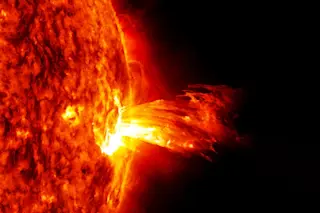Despite the surface beauty of planets and stars, what lies beneath is increasingly seizing astronomers’ attention. The interiors of celestial bodies, scientists now realize, may be crucial to understanding the prospects for life elsewhere in the universe.
Part of the new thinking comes from a better appreciation of how living things depend on what’s inside our own planet. Present theory holds that there is a Pluto-size solid iron ball at Earth’s center surrounded by an extensive zone of liquid iron. The circulation of this molten metal may produce the geomagnetic field that shields us from potentially lethal solar flares and cosmic rays. Above the two-part core lies the mantle, a 1,800-mile-thick expanse of hot, pliable rock. The slow churning of the mantle pulls in carbon compounds from the ocean floor and spits out carbon dioxide in volcanic eruptions, regulating global climate. The mantle’s movements also rearrange Earth’s geography, giving rise to ever-shifting habitats that seem to drive evolutionary change.
Elsewhere, life may be even more dependent on interior mechanisms. Data from NASA’s now-defunct Galileo spacecraft suggest that three of Jupiter’s giant moons—Callisto, Ganymede, and especially Europa—could support life tens or hundreds of miles under their surfaces. These planet-size worlds are squashed and stretched by their gravitational interactions with Jupiter and with one another. The resulting friction creates heat, possibly enough to keep water in a liquid state deep beneath the moons’ icy exteriors. Many scientists speculate that entire hidden oceans may lurk below. Liquid water is generally considered one of the key conditions for life.

Mars probably had an inner dynamo and a corresponding magnetic field for its first several hundred million years. Eventually, the planet’s core cooled and its protective field expired. Today solar particles arrive unimpeded, nibbling away at the thin Martian atmosphere and irradiating its surface.
Inside processes are not necessarily friendly to biology. Jupiter’s fast 10-hour rotation stirs up its insides and generates a huge magnetic field that is a few million miles wide and up to hundreds of millions of miles long. This invisible cocoon traps charged particles from the sun and whips them into a deadly frenzy. The particles constantly rain down on all of Jupiter’s nearby satellites, another reason why any organisms as we know them there could survive only underground.
The ultimate source of this life-threatening havoc is the sun, and again, the cause lies hidden within. The sun’s inner two-thirds rotates like a solid ball; the outer third is more fluid and rotates more quickly at the equator than at the poles. These differing motions amplify and twist the solar magnetic field, triggering huge explosions that blow through space. Astronomers are probing the process by watching acoustic oscillations that resonate through the sun’s outer layers (see “Here Comes the Sun,” Discover, May 2004). “With instruments that examine global oscillations at low frequency, we can look at the sun’s deep interior,” says Joe Gurman, U.S. project scientist for the European Solar and Heliospheric Observatory. “We hope to predict space weather based on studies of what’s beneath the surface.”
Of course, the sun also produces the light and heat that help sustain nearly every living thing on Earth. If life on other worlds is at all similar, it too must depend on a parent star. The sun’s luminosity originates in its core, where hydrogen fuses together to produce helium plus a great deal of energy. This process has kept Earth comfortably warm for 4.5 billion years, but it is not eternal. Computer calculations show that pressure in the core increases as helium accumulates, gradually causing the sun to brighten. In 1.1 billion years, it will be 10 percent more luminous than it is now, enough to evaporate the oceans and heat Earth to a near boil.
Most of summer’s prominent stars, such as blue-white Vega shining overhead these evenings, are more massive than the sun, meaning they have even greater pressures in their cores. As a result, they emit mostly harsh ultraviolet radiation and they burn out relatively quickly; nearby planets would face a fierce environment. Dull, sunlike stars such as 47 Ursae Majoris, a dim speck below the bowl of the Big Dipper, probably offer much better prospects for life. Such ordinary-looking stars suddenly seem extraordinarily precious, once we get the inside story.
THE SKY IN JULY
This month is a transitional time for the bright planets, as Jupiter descends into the twilight and Venus moves to the morning. Now is a fine time to learn your way around our galaxy.
July 5th: Venus shines brilliantly in the eastern predawn sky, forming a pretty pair with the red star Aldebaran.
July 10th: Mercury passes strikingly close by dimmer Mars low in the evening sky, visible just above a clear horizon.
July 21st: Jupiter makes an evening matchup with the crescent moon. Within weeks it will be invisible in the sun’s glare.
MONTHLONG ATTRACTIONS
Noctilucent clouds shimmer after sunset, catching solar rays in the stratosphere.
The center of our own Milky Way galaxy glows low in the south.
Star cluster M13 rides high overhead, a fuzzy ball seen through binoculars.














